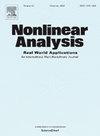具有振荡边界的非圆柱形区域的p-拉普拉斯热方程:均匀化过程
IF 1.8
3区 数学
Q1 MATHEMATICS, APPLIED
引用次数: 0
摘要
本文讨论了具有演化振荡边界的非圆柱形区域中p-拉普拉斯热方程的均匀化问题。利用坐标变换将p-拉普拉斯热方程转化为参考域中具有振荡系数的抛物型p-拉普拉斯方程。本文的新颖之处在于参考域中方程由非线性分量中的振荡系数矩阵组成,具体为|Mεtr∇Uε|p−2。通过一个非平凡的Galerkin近似证明了解在参考域中的存在唯一性,并给出了一个显著的ε-一致估计。另一方面,采用一种改进的双尺度收敛方法推导了双尺度均匀化问题。进一步,构造了非线性单元问题的显式解。将该解用于驱动参考域中的有效方程和修正结果,确定为具有有效演化边界的非圆柱形域中p-拉普拉斯热方程的转换有效问题。本文章由计算机程序翻译,如有差异,请以英文原文为准。
A p-Laplacian heat equation in a non-cylindrical domain with an oscillating boundary: A homogenization process
This article addresses the homogenization of the heat equation involving the -Laplacian in non-cylindrical domains with an evolving oscillating boundary. A change of coordinates is employed to transform the heat equations with -Laplacian into parabolic -Laplacian equations featuring oscillating coefficients in a reference domain. One novelty of this article is that the equation in the reference domain consists of an oscillating coefficient matrix in the nonlinear component, specifically . The existence and uniqueness of solutions are demonstrated in the reference domain through a non-trivial Galerkin approximation, accompanied by a significant -uniform estimate. On the other hand, a modified two-scale convergence method is employed to derive the two-scale homogenized problem. Furthermore, an explicit solution to the nonlinear cell problem is constructed. This solution is employed to drive the effective equation within the reference domain and corrector result, identified as a transformed effective problem of the heat equation with -Laplacian in a non-cylindrical domain featuring an effective evolving boundary.
求助全文
通过发布文献求助,成功后即可免费获取论文全文。
去求助
来源期刊
CiteScore
3.80
自引率
5.00%
发文量
176
审稿时长
59 days
期刊介绍:
Nonlinear Analysis: Real World Applications welcomes all research articles of the highest quality with special emphasis on applying techniques of nonlinear analysis to model and to treat nonlinear phenomena with which nature confronts us. Coverage of applications includes any branch of science and technology such as solid and fluid mechanics, material science, mathematical biology and chemistry, control theory, and inverse problems.
The aim of Nonlinear Analysis: Real World Applications is to publish articles which are predominantly devoted to employing methods and techniques from analysis, including partial differential equations, functional analysis, dynamical systems and evolution equations, calculus of variations, and bifurcations theory.

 求助内容:
求助内容: 应助结果提醒方式:
应助结果提醒方式:


